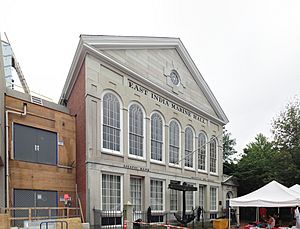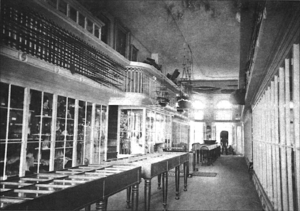East India Marine Society facts for kids
The East India Marine Society was a special group started in Salem, Massachusetts, in 1799. It was made up of people who had sailed far across the oceans, past places like the Cape of Good Hope (at the tip of Africa) or Cape Horn (at the tip of South America). These members were usually ship captains or supercargoes (people in charge of the cargo) from Salem.
The society had two main goals: to help its members and their families if they faced hard times, and to teach people about the world. They had a library and a museum filled with amazing things from their travels. The society was very important in the early 1800s, when Salem was a busy port for international trade. In 1910, the society changed its name slightly to "Trustees of the Salem East India Marine Society."
Today, in 2025, the East India Marine Society is being celebrated! The Peabody Essex Museum (PEM) in Salem, Massachusetts, is holding a big exhibition. This year is special because it marks 200 years since the East India Marine Hall was first opened in 1825. This building was the society's main home.

The Museum of Wonders
How the Museum Started
The people who started the East India Marine Society wanted to create a museum right from the beginning. Their goal was to collect "curiosities" – interesting and unusual objects – especially from places beyond the Cape of Good Hope and Cape Horn.
Within just three years, their collection grew so much that it was too big for their first building! So, they moved to a larger building on Essex Street.
In 1825, the society opened its very own building, the East India Marine Hall. It was designed by an architect named Thomas Waldron Sumner. This building also housed a bank and an insurance company.
The museum was known as the East India Marine Society museum until 1867. That year, a wealthy man named George Peabody bought it. He combined its collections with other items from the Essex Institute. This new place was called the Peabody Academy of Science. Later, in 1915, it became the Peabody Museum of Salem. Finally, in 1992, it joined completely with the Essex Institute to become the Peabody Essex Museum we know today.
The museum and its collections were very important for a few reasons. First, members had to donate interesting items from their trips. This made Salem a key place to learn about cultures from Europe and Asia. It also showed how successful America was in global trade. The museum helped America show that its cultural places were just as good as those in Europe. It also connected the business of trade with new ideas about science and society.
Amazing Collections from Around the World
The museum's collection began with donations from Captain Jonathan Carnes. He gave items like an elephant's tooth and a pipe from Sumatra. This set the example for what the museum would collect. Because members had to donate many different objects from their travels, the collections mostly featured items from the Pacific Ocean region, which was important for their trade.
The museum received so many objects in its first 20 years that it hired a curator. A curator is someone who manages and organizes a museum's collection. This curator helped fill in any missing items, arrange the displays, and create a list of everything. This list, called a catalogue, was published in 1821 and included 2,269 objects!
The museum had all sorts of things, like shells, coins, and cultural items. These included costumes, musical instruments, statues, and weapons. They also had handwritten journals from sea voyages between Salem and places like Batavia, Bombay, Calcutta, Canton, Ceylon, Isle de France (now Mauritius), Manila, Mocha, Sumatra, and Tranquebar. People who donated items included members, local New Englanders like William Bentley, and even merchants from other countries.
Ten years after the first list, a second one was released, showing a total of 4,299 objects! These lists included:
Natural Wonders
- Ostrich eggs
- A "pregnant queen ant"
- Stuffed penguins
- Elephant tails and tusks
- "Lava from Java"
- "A hornet's nest from Surinam"
- A two-headed dogfish
- Balls of hair from the stomachs of cows from Madagascar and Salem (for comparing them!)
Cultural Treasures
- "Fragments of granite broken from Pompey's pillar" (an ancient monument)
- Ivory pagodas (temple models)
- A model of an 80-gun ship, made from soup bones by a prisoner
- Coins and other foreign money
- "Specimens of white marble from the ruins of Carthage" (an ancient city)
- A coffee cup and saucer that belonged to Emperor Napoleon Bonaparte
- A "very elegant hubble-bubble" (a type of water pipe)
- Paintings and clothing from China, Japan, and India
- A medal with images of the devil and the Pope
- "Three thousand yards of human hair, braided"
- Female underwear from Lapland, made from reindeer hair
- "The elaborate terminal bead of a late medieval Flemish rosary"
Special Objects
Some items in the collection were extra special because they were rare, came from unique places, or had important history. One example is an idol of Kolia Moku, a medicine god from the Sandwich Islands. It was donated in the late 1840s, and there are only two other idols like it left in the world!
Another famous object was the embalmed head of a New Zealand chief. It was donated by William Dana and had to be displayed behind a veil.
An important early object was a sculpture donated in 1790 by Captain Benjamin Hodges. It was called Figure of a Chinese Man. Experts say it was one of the first sculptures from China to come to America.
What Was Missing
Even though the museum had many items from international trade, it had only a few objects from Native American tribes. Since there wasn't a strong financial reason to collect Native American items, the museum's display of Eastern tribes was small. These items, like arrowheads found in New England, were often shown alongside ancient artifacts from other parts of the world.
How Things Were Displayed
We don't have many records of how the museum looked, but we know a few things. When the society moved into the new East India Marine Hall, tall display cases filled with artifacts lined the walls. Often, models of ships were placed on top of these cases. More cases were arranged in the middle of the room.
The museum also had life-size sculptures of merchants from China and India. These were placed in key spots around the hall. They were not just objects to look at; they also helped explain the other items in the collection.
Before the 1830s, we don't know much about how the items were grouped. But by the end of that decade, records show that objects were displayed based on what they were used for, like weapons or musical instruments. The curator, Dr. Malthus Ward, did this to group objects that had similar purposes in different countries.
Who Visited the Museum?
The museum did not charge an entry fee, but visitors needed to be introduced by a society member. Many famous people visited, including Nathaniel Hawthorne, Andrew Jackson, and Martin Van Buren.
It was one of Salem's most popular attractions. Visitors often felt amazed, as if they were stepping into another world. Martha Nichols, whose grandfather was a Salem sailor, wrote that its "magic door opened onto so many wonders." A guestbook from 1860 even had a visitor's comment that "to walk around this room was to circumnavigate the globe" (meaning to travel around the world). These experiences taught younger generations in Salem about the global marketplace, which was very important in the early 1800s. Seeing these foreign items helped them understand the possibilities for trade with other nations.
Experts say that the exhibits in East India Marine Hall made visitors feel like the sailors had brought them a small piece of the entire world. The objects and their displays were not just meant to show the rich variety of other cultures. They were also strongly connected to the people who donated them. This was made clear by portraits of the donors hanging above the objects. Also, former sailors from the society often worked as tour guides. This showed the personal connections to the items and highlighted the sailors' independence and success in international trade.
Challenges for Visitors
The 1830s brought some difficulties for the museum and its visitors. In 1833, the society made a rule that stopped African Americans from visiting the museum, even though they had been allowed before. This was an unfair change. Also, for a short time, the museum started charging an entrance fee. This was because it had become too popular, with over 2,000 visitors each year. The society also had to help its members' families who were having money problems, and the costs became too high to keep it free for everyone.
Members
- The East India Marine Society had many members over the years, including important figures like Nathaniel Bowditch and Dudley Leavitt Pickman. These members were all sea captains or supercargoes who had sailed beyond the Cape of Good Hope or Cape Horn. They contributed to the society's goals of charity and education, and many donated items to the museum from their travels.
Vessels
- Many ships were connected to the East India Marine Society through its members. These vessels sailed to distant lands, bringing back goods and "curiosities" for the museum. Some of the well-known ships included the America, Astrea, Belisarius, Friendship, and Ulysses. These ships were vital for Salem's trade and for the society's collection of global artifacts.


